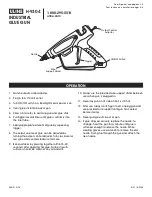
09
08
MAINTENANCE
Any time inspection, maintenance, and
cleaning are done:
◆
Disconnect the tool from the air source.
Empty the magazine completely.
◆
WARNING:
!
Make sure there is no fastener in
magazine before clearing a jam.
WARNING:
!
Disconnect the tool from the air source
whenever clearing a jam. After
disconnecting the tool from the air
compressor, there should still be enough
air pressure to fire the tool. After the air
hose is disconnected, always fire the tool
into scrap wood repeatedly to make sure
all of the compressed air is expended.
WARNING:
!
SETTING THE AIR PRESSURE
The amount of air pressure required depends on
the size of the fasteners and the workpiece material.
Begin testing the depth of drive by driving a test nail
into the same type of workpiece material used for
the actual job. Drive a test fastener with the air
pressure set at 90-95 psi. Raise or lower the air
pressure to find the lowest setting that will perform
the job with consistent results. It may be possible to
achieve the desired depth with air pressure
adjustments alone.
NON-MARRING PAD
The no-marring pad attached the nose of the tool
helps prevent marring and denting when working
with softer woods.
Disconnect the tool from the air source
before removing or replacing the no-
marring pad. Failure to do so could result
in serious personal injury.
WARNING:
!
DEPTH ADJUSTMENT
The driving depth of the fasteners are adjustable.
To adjust the depth, use the drive depth adjustment
wheel (G) on the right side of the tool.
Disconnect the tool from air source.
Turn the depth wheel left or right to change the
driving depth.
Reconnect the tool to the air source.
Drive a test nail after each adjustment until the
desired depth is set.
It is advisable to test the depth on a scrap
workpiece to determine the required
depth for the application.
To determine depth of drive, first adjust
the air pressure and drive a test fastener.
Never exceed 120 psi.
CAUTION:
Each tool is packed with an anti-dust cap on the air
connector,
Keep the anti-dust cap cover the air connector
when the tool is not in use.
check it after unpacking.
1.
2.
3.
4.
ANTI DUST CAP
-
Always know the operational mode of the
tool before using. Failure to know the
operational mode could result in death or
serious personal injury.
WARNING:
!
FIRING THE TOOL
The tool is specially designed for single sequential
mode. This mode requires the trigger to be pulled
each time a fastener is driven. The tool can be
actuated by depressing the WCE against the work
surface followed pulling the trigger.
The trigger must be released to reset the tool before
another fastener can be driven.
An improperly functioning tool must not
be used. Do not actuate the tool unless the
tool is placed firmly against the work
place.
WARNING:
!
WORK CONTACT ELEMENT (WCE)
Disconnect the air supply from the tool.
Remove all fasteners from the magazine.
Make sure the trigger and work contact element
move freely up and down without sticking or
binding.
Reconnect air supply to the tool.
Depress the work contact element against the
work surface without pulling the trigger. The tool
must not operate. Do not use the tool if it
operates without pulling the trigger. Personal
injury may result.
Remove the tool from the work surface. The
work contact element (WCE) must return to its
original down position. The tool must not
operate. Do not use the tool if it operates while
lifted from the work surface. Personal injury may
result.
Pull the trigger and depress the work contact
element (WCE) against the work surface. The
tool must not operate.
Depress the work contact element (WCE)
against the surface. Pull the trigger. The tool
must operate.
⒍
⒎
⒏
Check the operation of the work contact
element trip mechanism before each use.
The WCE must move freely without
binding through its entire travel distance.
The WCE spring must return the WCE to
its fully extended position after being
depressed. Do not operate the tool if the
WCE trip mechanism is not operating
properly. Personal injury may occur.
CAUTION:
Keep the tool pointed away from yourself
and others when loading fasteners.
Failure to do so could result in possible
serious personal injury.
WARNING:
!
Never load fasteners with the workpiece
contact or trigger activated. Doing so
could result in possible serious personal
injury.
WARNING:
!
UNLOADING FASTENERS
Unloading is the reverse of loading. Always
disconnect the air source before unloading.
Always unload all fasteners before removing
tool from service.
WARNING:
!
Always disconnect the air source before
unloading.
WARNING:
!
CLEARING JAMS
Disconnect the tool from air source.
Remove fasteners from the tool. Failure to do
so will cause the fasteners to eject from the front
of the tool.
Pull up on the latch (E) and open the jam
release (F).
Using caution not to bend or damage the driver
blade, using pliers or a screwdriver if required to
clear the jammed fastener.
Close the jam release and latch.
Reconnect the tool to the air source.
Reload the tool with fasteners.
Occasionally, a fastener may become jammed in
the firing mechanism of the tool, making the tool
inoperable. To remove a jammed fastener, follow
the steps below:
⒈
⒉
⒊
⒋
⒌
⒍
⒎
HTTP://WWW FREEMANTOOLS COM 1-888-669-5672
.
.
HTTP://WWW FREEMANTOOLS COM 1-888-669-5672
.
.
MODEL: PBR32Q
MODEL: PBR32Q
Latch (E)
Jam release (F)
Adjustment wheel(G)
1.
2.
3.
4.
5.






































